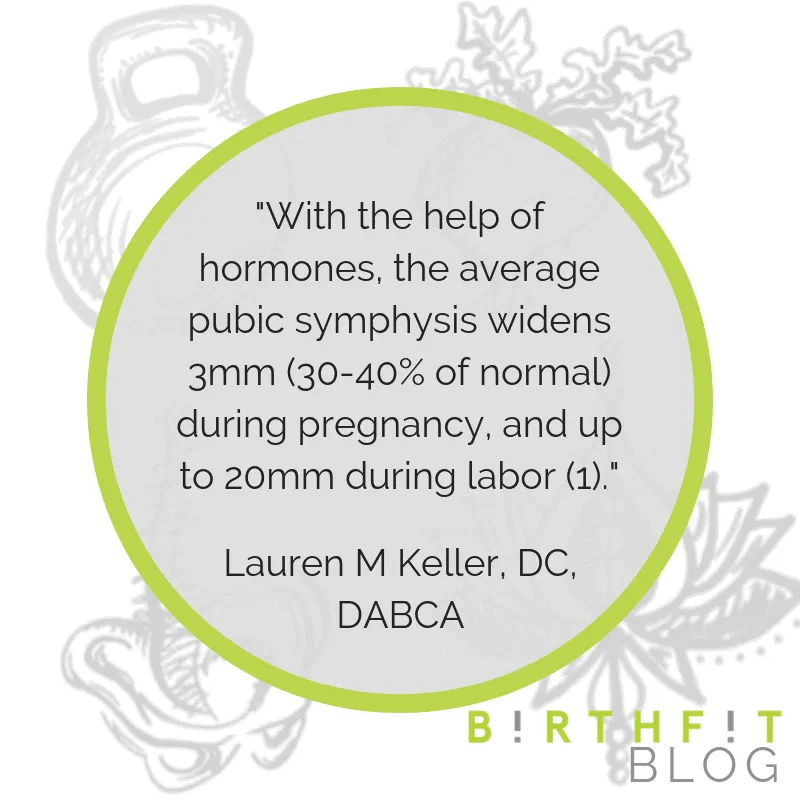Symphysis pubis pain is un-affectionately known as lightning crotch. It’s that feeling that 20% of pregnant women know all too well—the sharp and sudden pain deep in their pelvis. The feeling of their pelvis shearing, pain that can stop a mama mid-step or leave her gasping for air trying to roll over in bed. Affecting 1/5 of all pregnancies, it’s important to know what it is and what to do if you are one of the mamas affected.
What is the Pubic Symphysis?
The pubic symphysis is a cartilaginous joint that connects the left and right pubic bones. The pubic symphysis helps transfer weight during normal activities like walking, but also helps to stabilize the pelvis. During pregnancy, the pubic symphysis opens and expands in order to make more space for the baby to descend. With the help of hormones, the average pubic symphysis widens 3mm (30-40% of normal) during pregnancy, and up to 20mm during labor (1). This widening is extremely beneficial to allow the baby to rotate, the pelvis to open and the baby to descend.
What are the Signs and Symptoms of Symphysis Pubis Dysfunction (SPD)?
SPD can present in many ways from a mild twinge of pain to a debilitating pain. Here are a list of ways pubic symphysis pain can show up:
- Sharp pain at front of pelvis
- Pelvic/pubic radiating to upper thigh/groin
- Throbbing or deep, achy pain around hips, low back, lower abdomen or perineum (between vagina and anus)
- Pain with transferring weight from one leg to another – pain with walking, standing on one leg, climbing stairs, getting in/ out of the car or bed and rolling over in your sleep
- Clicking or popping sound of pelvis accompanied with pain or discomfort
- “Pregnancy waddle” to avoid pain
What Causes Pelvic Pain During Pregnancy?
Like most of women’s health care, especially around pregnancy and postpartum, we do not know the cause of SPD. Realistically, there is not one cause, but instead SPD is related to a variety of factors and it’s important to find the root cause for yourself. However, here are some theories as to the links/causes of pelvic pain during pregnancy and postpartum:
- Prior pelvic trauma
- Hypermobility: Whether you have a connective tissue disorder like Ehlers-Danlos Syndrome or are just generally bendy, excessive mobility in the pelvis can lead to increased instability.
- Pelvic joints not moving properly (unequal muscle pull), bony misalignment: As we naturally progress throughout pregnancy we alter our general posture including the angle of our pelvis. Changes in biomechanics, along with added weight and gravity, can lead to increased pressure in the pubic region.
- Baby positioning: Those kiddos can be an adventure before they even make it Earth-side. If a baby is posterior (the back of the baby’s head is against your back), asynclitic (the baby is asymmetric in the pelvis with the head tipped to one side) or transverse (the baby is lying sideways like (s)he is in a hammock), it may lead to increased pressure or pain on the pubic bone.
- Repetitive motion: If your occupation, hobbies, or past fitness routines were one-sided like running, skating, or softball, this may be shown in muscular imbalances that can lead to uneven force transfer and mobility/stability.
- Hormones: During the first trimester there is an increase of relaxin and progesterone and a decrease in estrogen. These hormones helps increase joint laxity to allow for the opening of the pelvis. The studies are inconclusive, but the decrease in estrogen along with the increase in relaxin and progesterone levels may be related to SPD in some women.
Managing Pubic Symphysis Dysfunction Through Exercise
The most important thing to know is that each mama is unique in her needs. For that reason, it is important to see a chiropractor or physical therapist with additional training in pregnancy and postpartum to find your specific needs. With that being said, there are some general guidelines. Y’all know by now that I love mamas to stay active during pregnancy but there are some exercises that are best modified or taken out when you have SPD.
The ‘don’ts’ Of Exercising With Pubic Symphysis Pain (exercises To Avoid With Lightning Crotch):
- Don’t over-stretch
- Yes, it is possible to over-stretch, especially during pregnancy when hormones are helping muscles and ligaments relax in order to prepare for birth. If you are doing yoga or pilates, it’s a great idea to not push mobility at the end of any pose as this can increase your risk for stretching too much and destabilizing the pelvis.
- Avoid single leg movements for a few weeks (2-3 weeks) and slowly add them back in to see if you can manage the load. If not, that’s OK and take them back out. If they do not increase or cause pain, it’s a great idea to gradually add them back!
- This includes taking out lunges, bulgarian split squats, pistol squats, warrior pose, assault bike, and step ups as all of these exercises are one-leg dominant and can increase shearing on the pelvis.
- Avoid traditional “core” exercises
- Traditional core exercises like sit-ups and crunches focus on activating one or two muscles independently of the core system (diaphragm, pelvic floor and all abdominal and back musculature). Working these muscles can actually pull on the pubic bones and increase pain. Core exercises like the plank are advanced and require full pelvic/core stability and joint centration (the pelvic floor and diaphragm should be aligned). It is common for mamas to compensate during this movement as their natural gravity shifts and this compensation can lead to increased pelvic and low back instability.
- No deep squats, sumo squats or sumo deadlifts
- I love deep squats because the bottom of a squat is when the pelvic floor is most relaxed (hello benefits in labor), BUT that stretch can be too much with pelvic pain and is best to be avoided.
- Avoid adductor stretches or adductor machines
- The adductors are connected to both the inner thigh and the pelvis and can definitely play a role in pelvic pain. Like most everything, it is best to figure out if the adductors need to be relaxed or strengthened. If you are constantly stretching and they don’t feel better, they may actually need to be strengthened! Vice versa, if you’ve been working hard to strengthen the adductors but they continue to be sore, you may need to calm the signal from the brain to down regulate this pain. The best way to know this is to see a professional who can guide you in what your body currently needs.
- Fast/explosive movements
- We want to continue moving during pregnancy, but fast and explosive movements, such as jogging, running, skating, sprinting or jumping on a box, require the musculature around the pelvis to respond quickly, and when there is pain, this reaction is often slower. It is easier to compensate and not utilize the appropriate muscles to create the force to stabilize.
Exercises That May Improve Pubic Symphysis Pain
- Focus on posture and pelvic alignment
- As you stand and walk your diaphragm should be aligned with your pelvic floor — this is a neutral spine. If you drop into too much anterior or posterior pelvic tilt, this can increase pain/pressure on the pubic region. An easy exercise to focus on posture and pelvic alignment is to stand in front of a mirror and focus on finding that neutral spine.
- BREATHE
- As we inhale, our pelvic floor gently descends and relaxes and as we exhale it gently lifts and contracts. This is a normal progression with diaphragmatic breathing that naturally helps to activate the deep abdominal muscles and stabilize the pelvic region with the breath.
- Balance strength and mobility
- All movements should be slow and intentional with a focus on maintaining task-specific IAP. This intention trickles down to balancing strength and mobility so we aren’t over-stretching or strengthening a muscle that does not have its full range of motion.
- Work the glutes and adductors in synergy through movement
- Banded monster walks
- Glute bridges with band around knees and yoga ball or block in-between knees
- BIRTHFIT Basics - Bear with bands around knees and yoga ball or block in-between knees —> if you are able to do this and looking to advance the movement without doing a bear crawl, you can simply lift and hold one arm or one leg at a time.
- Banded good mornings
- 90/90 or Shin box flow: this is a movement where slow and intentional movements are best.
- Work all of the core together
- Box squats: I mentioned earlier that deep squats may not be beneficial but shortening the range of motion to the point before there is pain can be extremely helpful in pelvic pain and keeping pelvic mobility with core stability.
- BIRTHFIT Basic- Side Plank with no kick through
- BIRTHFIT Basics- Bird Dog and focus on breathing and elongating spine.
- BIRTHFIT Basic- Dead Bug
Mama, if you are struggling with pubic symphysis pain or any pelvic pain, I understand the frustration, anger, and fear that comes along with it. I believe that no woman should have to suffer through pregnancy or postpartum in pain. To find local resources, reach out to a BIRTHFIT Regional Director, Professional, or Coach or find a Webster Certified Chiropractor and Women’s Health Physical Therapist near you.
Lauren M Keller, DC, DABCA
References:
- Jain, Smita, et al. “Symphysis pubis dysfunction: a practical approach to management.” The Obstetrician & Gynaecologist 8.3 (2006): 153-158.
This blog was originally posted on drlaurenkeller.com

